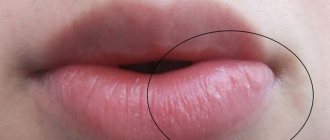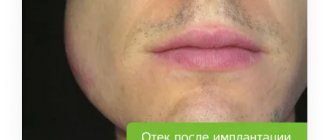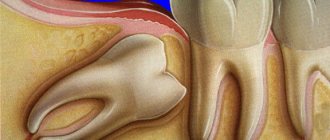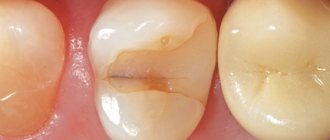Reasons why the cheek swells after tooth extraction
After tooth extraction, an inflammatory process occurs in the soft tissues of the oral cavity - this is the main cause of edema and swelling. If the operation is performed correctly and the patient has followed all the dentist’s recommendations, the non-infectious inflammation will go away on its own, without antibiotics or complications, and along with it, pain and swelling will go away.
The duration of swelling varies depending on the surgical technique, which tooth was removed, the condition of the oral cavity, and finally, the physical condition of the patient and his immune system. On average, swelling lasts 3-4 days, but can last for 7 days. If after a week the swelling has not subsided, this is a sign of the development of complications and a reason to consult a specialist.
Swelling appears a few hours after surgery (after the anesthesia wears off). At the same time, the patient may feel aching pain, and ichor is released from the wound. A slight increase in temperature is allowed. All these symptoms are considered natural and do not pose any danger. And to relieve pain, you can take painkillers analgesics.
Maximum swelling is recorded on days 3-4, from this moment it begins to decrease and by the seventh day it completely disappears. But the cheek can swell immediately after depulpation; this happens if the patient had gumboil and the tumor developed even before the operation.
How to help yourself eliminate swelling after tooth extraction
After tooth extraction, the patient is faced with the task of following all the doctor’s instructions exactly. This is the only way to minimize pain and swelling.
To avoid contamination and infection, the surgeon washes the hole with an antiseptic solution. Over the next 5-7 days, the dentist will often prescribe anti-inflammatory drugs and/or antibiotics. Patients with weakened immune systems are advised to take vitamin supplements.
If negative symptoms increase, self-medication will not help, but will only worsen the situation. Therefore, the following measures must be observed to help shorten the rehabilitation period and avoid complications:
- do not heat the area where the tooth was removed;
- the first meal should be no earlier than 3-4 hours after extraction;
- do not smoke or drink alcohol during rehabilitation;
- eat only soft and warm foods for 10-12 days;
- do not chew on the side where the manipulation was performed;
- Do not brush the damaged area of the gum with a toothbrush;
- do not destroy the blood clot;
- Rinse your mouth with caution after brushing your teeth.
In addition, try to avoid physical activity, do not take a hot bath, or visit the sauna. It is advisable to monitor your body temperature on the first day after tooth extraction. It should not be higher than 37.5 degrees.
Do not take painkillers on your own, do not treat the wound with various compounds and gels. Only your attending physician can prescribe medications.
Cheek swelling during wisdom tooth removal
Extraction of extreme molars (wisdom teeth) is considered one of the most difficult tooth extraction operations. It is accompanied by an incision of soft tissues and suturing, so inflammation after it is inevitable. Swelling after wisdom teeth removal lasts longer and is accompanied by pain.
Moreover, an elevated temperature may persist for several days, the patient may have difficulty swallowing, and experience pain when opening the mouth and during speech.
In this case, there is a risk of infection and serious inflammation, therefore, after depulping the extreme molars, it is necessary to take antibiotics and rinse the mouth with antiseptic solutions.
Why does pain occur after an injection into the gum?
Since the needle is inserted into soft tissues, it injures them and provokes discomfort. The patient may feel pain at the injection site for 1-2 days, or even more. The duration of the recovery period depends on the characteristics of the body and the perception of stimuli at the neuropsychic level.
Overly sensitive patients should be prepared for aching pain. Most often, no action is required. Usually the pain subsides on its own. In the case when it does not go away and only gets worse over time, we can talk about the development of a complication. At the same time, other signs of disturbances may occur.
Sometimes the patient thinks that the injection site hurts, but the localization is in a different place. So, after caries treatment, you may feel aching pain that radiates to the gums. Removal of a wisdom tooth is accompanied by pain in the socket, while the patient thinks that the problem is localized at the injection site.
Other causes of cheek swelling
Along with natural, so-called non-infectious inflammation, there are other causes of cheek swelling:
- tooth extraction due to gumboil;
- extraction with complications - in case of incorrect inclination or direction of tooth growth, when removing massive teeth and teeth with long roots;
- the presence of infection and inflammation in soft tissues;
- allergic reaction to medications or anesthesia;
- individual intolerance to components in medications or anesthetics;
- errors during extraction, insufficient antiseptic treatment of the oral cavity and residual infection;
- the presence of chronic diseases – hypertension, neuralgia, psycho-emotional pathologies;
- failure by the patient to comply with the recommendations of the dental surgeon, refusal of prescribed antibiotics or reduction of their dosage.
Most often, the tumor is caused by improper oral care, lack of disinfection with antiseptics, and skipping medications.
Reason to see a doctor
The following symptoms require a visit to the dental office:
- severe pain at the injection site and its increase;
- significant swelling of the gums that remains after the anesthesia wears off;
- purulent or sanguineous discharge from gum tissue;
- temperature increase;
- compaction (“petrification”) of gum tissue in the affected area;
- looseness of the gums under the tooth, which was amenable to treatment, their slight displacement when exposed.
During the examination, the doctor will determine the cause of the development of undesirable effects.
Possible complications
If after seven days the tumor not only has not gone away, but has also grown and become denser, this indicates a progressive inflammatory process.
At the same time, other symptoms may appear: pain in the gums and cheeks (aching, cutting, throbbing), redness of the cheeks and gums, fever, weakness, loss of appetite, headache.
What complications can inflammation lead to:
- Alveolitis or “dry socket” - after a tooth is removed, a blood clot forms in the resulting socket. It serves as a protection and barrier to bacteria and protects the wound from infection. If it is somehow removed, the soft tissues are left without protection, pathogenic bacteria penetrate into them and suppuration begins. In advanced cases, inflammation spreads to other areas of the jaw; not only the cheek, but also the cheekbones and even the eye area swell.
- If, in addition to the tumor, the patient experiences severe pain in the jaw, this may indicate the development of osteomyelitis - inflammation of the bone tissue. The swelling on the cheek grows, spreading to the cheekbones and other parts of the face, the pain spreads to both jaws, the patient experiences pain when opening the mouth. If you do not consult a specialist in time, the disease can lead to blood poisoning.
- A gum abscess is a purulent inflammation inside the gum tissue. It is dangerous due to the spread of inflammation to other tissues, loosening and loss of teeth.
- Periostitis of the jaw (flux) is an inflammation of the jaw, characterized by increased temperature and severe pain in the jaw and temporal part. If left untreated, the flux can spread to the infraorbital area. In chronic form it can develop into osteomyelitis.
- Neuritis is damage to the facial nerve, accompanied by severe pain and swelling. A distinctive symptom is swelling of the larynx, palate, tongue, and cheeks.
Each of these complications can cause serious consequences, which is why it is so important to diagnose and treat in a timely manner.
When swelling after tooth extraction is a cause for concern
If you are concerned that swelling is not going down, also pay attention to the following symptoms:
- the tumor has spread to a significant part of the face;
- swelling persists for more than five days;
- you continue to experience severe pain;
- your temperature is above 37.5;
- there was an unpleasant odor in the mouth;
- it hurts you to chew and swallow;
- the mucous membrane and skin turned red (an allergic reaction occurred).
The presence of one or more accompanying symptoms indicates that you are experiencing complications and should immediately consult a doctor to take the necessary measures to avoid serious consequences.
How to eliminate cheek swelling
It is impossible to completely remove the tumor until the inflammatory process stops, but you can reduce it and minimize discomfort and pain. This can be done with ice and cold compresses. You need to apply a compress every half hour, but no longer than 10-15 minutes, otherwise it can cause hypothermia and tissue necrosis.
In addition, you can drink painkillers, analgesics, take baths and rinses with an antiseptic solution. Take antibiotics if prescribed by your doctor. This will eliminate the infection and speed up tissue healing.
In general, swelling of the cheek is a normal phenomenon if it occurs a couple of hours after tooth extraction and goes away no later than the seventh day after it. In all other cases, immediate specialist consultation, diagnosis and treatment are required.
Complications after injection of anesthetic into the gums
Depending on the amount of blood released from the vessel and the individual characteristics of the body, it often takes 4 to 10 days for a bruise on the gum to disappear. Otherwise, this is already a complication.
| Type of complication | Features of manifestation | Symptoms |
| Accession of infection | There are always millions of bacteria in your mouth. In a normal state, they are in a certain balance, but under favorable conditions, for example, when immunity decreases, they can be activated. Thus, clotted blood becomes a nutrient medium for them. Pathogens begin to multiply. Pathogenic microorganisms can spread to periodontal tissue, the alveolar process that holds the tooth, periosteum and bone. Much depends on the type of pathogen and the location of the bruise. | Tissue infection is accompanied by the following symptoms: · painful sensations; · temperature increase – up to 39 ˚С; · weakness; · headache; Redness of the gum tissue. |
| Damage to the nerve trunk | If the doctor acts incorrectly, nerve fibers may be damaged as a result of the administration of anesthesia. In this case, it is important to contact a neurologist and maxillofacial surgeon as quickly as possible. | The patient feels a sharp pain immediately when the injection is given. It will subside for the duration of the anesthetic, but then resume again. It cannot be stopped even with the help of painkillers. If a large nerve trunk is affected, pain will be felt throughout the entire mouth, cheek and ear. It is even possible to turn off the chewing function and numbness of the face. Sometimes it is difficult to open your mouth completely; one side may sag. |
| Tissue necrosis | A very dangerous complication. The reason for its development may be the patient’s ailment, which he was silent about, vasospasm, too much anesthetic or its rapid administration. | The patient first feels a sharp, growing pain. It subsides for a short time, but this does not indicate that the danger has passed. The pain disappears due to tissue death. |
Complications after tooth extraction often occur due to the penetration of bacteria through the hole into various tissues of the dentofacial apparatus. Pus accumulates.
Symptoms of inflammation in the mouth
Inflammation of the oral mucosa involves not only its superficial layers, but also often the gums and periodontium. The latter is the ligamentous apparatus of the tooth and holds it in the bone. When these structures are damaged, the following complaints and symptoms arise: pain and redness, bleeding, swelling, the appearance of periodontal pockets, and an unpleasant odor. As the process progresses, suppuration and mobility of supporting teeth and enlargement of regional lymph nodes may appear. All of the above symptoms require specialist intervention, elimination of the cause and treatment.
How to reduce tissue swelling after implant installation?
Although swelling of the gums after implantation and swelling of the adjacent soft tissues are expected and considered normal, this condition must be dealt with. To do this, prepare gauze or clean, thin cotton towels at home in advance and freeze a large number of ice cubes.
Immediately after surgery:
- remove the ice from the freezer, put it in a plastic bag and wrap it in a towel;
- Sit in a comfortable place, with your upper body elevated;
- apply the prepared cold bundle to the cheek on the side where the implantation was performed;
- hold the cold compress for five to seven minutes, then take a 10-minute break and repeat the procedure.
Apply ice according to the described scheme several times for one and a half to two hours. On the first day, it is allowed to do several such approaches, in agreement with the doctor.










